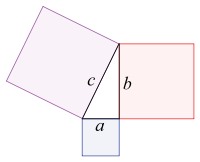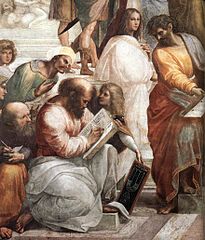Triples and quadruples: from Pythagoras to Fermat

Pythagoras' theorem. Image: Wapkaplet.
If there’s one bit of maths you remember from school it’s probably Pythagoras’ theorem. For a right-angled triangle with sides  ,
,  ,
,  , where
, where  is the side opposite the right angle, we have
is the side opposite the right angle, we have

If three positive whole numbers  ,
,  and
and  satisfy this equation — if they form the sides of a right-angled triangle — they are said to form a Pythagorean triple.
satisfy this equation — if they form the sides of a right-angled triangle — they are said to form a Pythagorean triple.
One question that intrigued Pythagoras himself, as well as other ancient Greek mathematicians, is how to generate Pythagorean triples. If I give you a positive number  , can you find two numbers
, can you find two numbers  and
and  so that
so that  ,
,  and
and  form a Pythagorean triple? In this article we’ll explore this question, and we’ll also see how the idea extends to sets of four numbers, called Pythagorean quadruples.
form a Pythagorean triple? In this article we’ll explore this question, and we’ll also see how the idea extends to sets of four numbers, called Pythagorean quadruples.
Pythagorean triples
First of all, here are some examples of Pythagorean triples:

Some Pythagorean triples.
The triples written in red are multiples of each other and so are the triples written in blue: you get 
 and
and  by multiplying the components of
by multiplying the components of  by 2, 3 and 4 respectively, and you get
by 2, 3 and 4 respectively, and you get  by multiplying the components of
by multiplying the components of  by 2.
by 2.
In general, if  is a positive whole number and
is a positive whole number and  is a Pythagorean triple, then so is
is a Pythagorean triple, then so is  , since
, since
![\[ (ka)^2+(kb)^2 = k^2a^2+k^2b^2 = k^2(a^2+b^2)=k^2c^2=(kc)^2. \]](/MI/7d39d123b72e66b363d59f129a37c4bb/images/img-0010.png) |
Geometrically, if one Pythagorean triple is a multiple of another, then the corresponding triangles are similar.

Pythagoras as depicted by Raffaello Sanzio in his painting The school of Athens.
If a Pythagorean triple isn’t a multiple of another Pythagorean triple, then we say that it is a primitive triple. You can recognise a primitive Pythagorean triple by the fact that the numbers  and
and  do not have a common divisor. In our example
do not have a common divisor. In our example  is a primitive Pythagorean triple while
is a primitive Pythagorean triple while 
 and
and  are not. Similarly
are not. Similarly  is a primitive triple whereas
is a primitive triple whereas  is not.
is not.
![\[ a^2+b^2=c^2 \]](/MI/864e8f7ba3982c4cbd43c864b5910148/images/img-0001.png) |
then
![\[ c^2-b^2=a^2. \]](/MI/864e8f7ba3982c4cbd43c864b5910148/images/img-0002.png) |
Now consider the two expressions
![\[ (a^2+1)^2 = a^4+2a^2+1 \]](/MI/864e8f7ba3982c4cbd43c864b5910148/images/img-0003.png) |
and
![\[ (a^2-1)^2 = a^4-2a^2+1. \]](/MI/864e8f7ba3982c4cbd43c864b5910148/images/img-0004.png) |
They differ by exactly  so the two expressions
so the two expressions
![\[ \frac{(a^2+1)^2}{4} \]](/MI/864e8f7ba3982c4cbd43c864b5910148/images/img-0006.png) |
and
![\[ \frac{(a^2-1)^2}{4} \]](/MI/864e8f7ba3982c4cbd43c864b5910148/images/img-0007.png) |
differ by 

Plato (left) with Aristotle (right) as depicted by Raffaello Sanzio in his painting The school of Athens.
Therefore, if we choose
![\[ b=\sqrt{\frac{(a^2-1)^2}{4}}=\frac{(a^2-1)}{2} \]](/MI/1effcbbbf304a3ea163eec60c629b59b/images/img-0001.png) |
and
![\[ c=\sqrt{\frac{(a^2+1)^2}{4}}=\frac{(a^2+1)}{2} \]](/MI/1effcbbbf304a3ea163eec60c629b59b/images/img-0002.png) |
we have
![\[ a^2+b^2 = a^2 + \frac{(a^2-1)^2}{4} = \frac{(a^2+1)^2}{4} = c^2. \]](/MI/1effcbbbf304a3ea163eec60c629b59b/images/img-0003.png) |
For the numbers  ,
,  and
and  to represent a Pythagorean triple we need
to represent a Pythagorean triple we need
![\[ b =\frac{(a^2-1)}{2} \]](/MI/ed52c875b655ead650bc2451c1d5d75d/images/img-0001.png) |
and
![\[ c = \frac{(a^2+1)}{2} \]](/MI/ed52c875b655ead650bc2451c1d5d75d/images/img-0002.png) |
to be whole numbers. This means that both
![\[ a^2-1 \]](/MI/ed52c875b655ead650bc2451c1d5d75d/images/img-0003.png) |
and
![\[ a^2+1 \]](/MI/ed52c875b655ead650bc2451c1d5d75d/images/img-0004.png) |
need to be even, which in turn implies that  needs to be odd. But the square of a number is odd only if the number itself is odd, so this method only works for odd
needs to be odd. But the square of a number is odd only if the number itself is odd, so this method only works for odd  .
.
There is however an easy way to derive a formula for even values from the above. If  ,
,  and
and  form a Pythagorean triple of the form described above, then so do
form a Pythagorean triple of the form described above, then so do
![\[ a_1=2a, \]](/MI/ed52c875b655ead650bc2451c1d5d75d/images/img-0009.png) |
![\[ b_1=2b=a^2-1=\left(\frac{a_1}{2}\right)^2-1 \]](/MI/ed52c875b655ead650bc2451c1d5d75d/images/img-0010.png) |
![\[ c_1=2c=a^2+1=\left(\frac{a_1}{2}\right)^2+1. \]](/MI/ed52c875b655ead650bc2451c1d5d75d/images/img-0011.png) |
This method for generating triples from even numbers  has been attributed to Plato. Here is a list of Pythagorean triples generated from both even and odd numbers using these two methods:
has been attributed to Plato. Here is a list of Pythagorean triples generated from both even and odd numbers using these two methods:

Since the methods give us a triple for every positive whole number we see that there are infinitely many Pythagorean triples. But can these methods generate all of them? The answer is no. For example, the triple  is absent from the list above. A general formula was described by Euclid in his famous book The Elements. Take any two positive whole numbers
is absent from the list above. A general formula was described by Euclid in his famous book The Elements. Take any two positive whole numbers  and
and  with
with  . Similarly to our reasoning above, notice that
. Similarly to our reasoning above, notice that
![\[ (m^2-n^2)^2 = m^4-2m^2n^2 +n^4 \]](/MI/1e46aa2c09ac73a39550184f5796b826/images/img-0005.png) |
and
![\[ (m^2+n^2)^2 = m^4+2m^2n^2 +n^4 \]](/MI/1e46aa2c09ac73a39550184f5796b826/images/img-0006.png) |
differ by  So setting
So setting
![\[ a = m^2-n^2 \]](/MI/1e46aa2c09ac73a39550184f5796b826/images/img-0008.png) |
![\[ b=\sqrt{4m^2n^2} = 2mn \]](/MI/1e46aa2c09ac73a39550184f5796b826/images/img-0009.png) |
![\[ c=m^2+n^2 \]](/MI/1e46aa2c09ac73a39550184f5796b826/images/img-0010.png) |
gives
![\[ a^2+b^2=c^2. \]](/MI/1e46aa2c09ac73a39550184f5796b826/images/img-0011.png) |
Since  and
and  are positive whole numbers and
are positive whole numbers and  all three numbers
all three numbers  ,
,  and
and  are also positive whole numbers, so we have a Pythagorean triple. Every primitive Pythagorean triple can be generated from a unique pair of numbers
are also positive whole numbers, so we have a Pythagorean triple. Every primitive Pythagorean triple can be generated from a unique pair of numbers  and
and  , one of which is even. And once you have the primitive ones you can generate all Pythagorean triples simply by multiplying. So Euclid’s formula really does give you all the triples there are.
, one of which is even. And once you have the primitive ones you can generate all Pythagorean triples simply by multiplying. So Euclid’s formula really does give you all the triples there are.
Pythagorean quadruples
Now let’s look at Pythagorean quadruples which consist of four positive whole numbers instead of three. In a Pythagorean quadruple the sum of squares of first three numbers gives us the square of the fourth:
![\[ a^2+b^2+c^2=d^2. \]](/MI/e5673d2deef83809bd32da9e1d68bc20/images/img-0001.png) |

 ,
,  and
and  . The length of the diagonal of this box is
. The length of the diagonal of this box is ![\[ \sqrt{a^2+b^2+c^2}. \]](/MI/50d271fc874be97fafcaaf5ed264ad18/images/img-0004.png) |
 is a Pythagorean quadruple, then so is
is a Pythagorean quadruple, then so is  for any positive whole number
for any positive whole number  . If the greatest common divisor of
. If the greatest common divisor of  ,
,  and
and  is 1 then the quadruple is called primitive. Here are some examples of Pythagorean quadruples with members that are multiples of each other in the same colour (red, blue or green):
is 1 then the quadruple is called primitive. Here are some examples of Pythagorean quadruples with members that are multiples of each other in the same colour (red, blue or green):
Some Pythagorean quadruples.
We can generate a Pythagorean quadruple from any two numbers  and
and  simply by noting that
simply by noting that
![\[ (m+n)^2=m^2+2mn+n^2. \]](/MI/6617e90341f17c1d0f415f6e5ffffd58/images/img-0003.png) |
Thus, setting
 and
and  gives us a Pythagorean quadruple.
gives us a Pythagorean quadruple.
This also gives us a way of generating a Pythagorean quadruple from a single even number  . Firstly, note that if
. Firstly, note that if  is even, then
is even, then  is even. Now find two numbers
is even. Now find two numbers  and
and  so that
so that  Set
Set
![\[ a=m \]](/MI/6617e90341f17c1d0f415f6e5ffffd58/images/img-0009.png) |
![\[ b=p=\sqrt{2mn} \]](/MI/6617e90341f17c1d0f415f6e5ffffd58/images/img-0010.png) |
![\[ c=n \]](/MI/6617e90341f17c1d0f415f6e5ffffd58/images/img-0011.png) |
and
![\[ d=(m+n)^2. \]](/MI/6617e90341f17c1d0f415f6e5ffffd58/images/img-0012.png) |
Then
![\[ a^2+b^2+c^2 = m^2+ 2mn + n^2 = (m+n)^2 = d^2 \]](/MI/6617e90341f17c1d0f415f6e5ffffd58/images/img-0013.png) |
gives us our Pythagorean quadruple. For example, if  , then
, then  so choose
so choose  and
and  We get the quadruple
We get the quadruple  with
with
![\[ 1^2+2^2+2^2 = 1+4+4=9=3^2. \]](/MI/6617e90341f17c1d0f415f6e5ffffd58/images/img-0019.png) |
For  we have
we have  We now have two choices as
We now have two choices as  and
and  The first choice gives the quadruple
The first choice gives the quadruple  with
with
![\[ 2^2+4^2+4^2 = 4+16+16 = 36 = 6^2. \]](/MI/6617e90341f17c1d0f415f6e5ffffd58/images/img-0025.png) |
The second choice gives the quadruple  with
with
![\[ 1^2 + 4^2+8^2 = 1 + 16 + 64 = 81 = 9^2. \]](/MI/6617e90341f17c1d0f415f6e5ffffd58/images/img-0027.png) |
You can continue to generate quadruples from even numbers  in this way.
in this way.
Can we generate all Pythagorean quadruples?
Not all Pythagorean quadruples are of the form
![\[ (m+n)^2=m^2+2mn+n^2, \]](/MI/6d5a08403e9bdf9f91ed3f2d2f662afb/images/img-0001.png) |
so not all of them can be generated using the method we just described — we need to be a little cleverer. Suppose that you’re given two numbers  and
and  Now find a number
Now find a number  which divides
which divides  but so that
but so that  If
If  and
and  are both even, then we also require that
are both even, then we also require that  itself is even.
itself is even.

Euclid (the man with the compass) as depicted by Raffaello Sanzio in his painting The school of Athens.
![\[ c= \frac{a^2+b^2-p^2}{2p}. \]](/MI/e2f9e5cb4b3c95017fc753f7d766b868/images/img-0001.png) |
 |
 |
 |
|||
 |
 |
 |
|||
 |
 |
 |
|||
 |
 |
 |
So letting
![\[ d = \frac{(a^2+b^2+p^2)}{2p} \]](/MI/3257af582ce378a3c99bc2d49fd179d0/images/img-0001.png) |
we have
![\[ a^2+b^2+c^2=d^2. \]](/MI/3257af582ce378a3c99bc2d49fd179d0/images/img-0002.png) |
But are  ,
,  ,
,  and
and  positive whole numbers? This is why we’ve imposed conditions on
positive whole numbers? This is why we’ve imposed conditions on  You can show that as long as
You can show that as long as  and
and  are either both even, or if one is even and one is odd, then the conditions ensure that
are either both even, or if one is even and one is odd, then the conditions ensure that  ,
,  ,
,  and
and  are positive whole numbers.
are positive whole numbers.
(Click here to see why.)
If  and
and  are both odd it is impossible to generate a Pythagorean quadruple from them by this method.
are both odd it is impossible to generate a Pythagorean quadruple from them by this method.
But the important point is that you can construct every primitive Pythagorean quadruple from two numbers  and
and  in the way we’ve just shown. And again, once you have the primitive ones, you can get all the others just by multiplying.
in the way we’ve just shown. And again, once you have the primitive ones, you can get all the others just by multiplying.
Generating a series of squares
Another nice thing to notice is that using our mechanism for generating triples, we can make sums of squares of any length. Let’s start with the triple  We can generate another triple starting with the number 5: it’s
We can generate another triple starting with the number 5: it’s  Thus we have
Thus we have
![\[ 3^2 + 4^2 = 5^2 \]](/MI/13667dfe4904dc6c54bd4e0343a9402c/images/img-0003.png) |
and
![\[ 5^2 + 12^2 = 13^2. \]](/MI/13667dfe4904dc6c54bd4e0343a9402c/images/img-0004.png) |
Rearranging the second equation gives
![\[ 5^2 = 13^2-12^2. \]](/MI/13667dfe4904dc6c54bd4e0343a9402c/images/img-0005.png) |
Substituting this into the first equation and rearranging gives
![\[ 3^2+4^2+12^2=13^2, \]](/MI/13667dfe4904dc6c54bd4e0343a9402c/images/img-0006.png) |
so we have the quadruple  Proceeding in a similar way, always using the biggest of the current set of numbers to generate a new triple, we can construct the quintuple
Proceeding in a similar way, always using the biggest of the current set of numbers to generate a new triple, we can construct the quintuple  and the sextuple
and the sextuple  and so on, ad infinitum.
and so on, ad infinitum.
Cubes and beyond
Pythagorean quadruples consist of a sum of squares, but what if we look at sums of cubes of the form
![\[ a^3+b^3+c^3=d^3. \]](/MI/00e8c79fdd147cc8e8825c04bb3ae3f6/images/img-0001.png) |
These are called cubic quadruples. Here are a few examples (again, quadruples written in red, blue or green are multiples of each other).

Some cubic quadruples.
We won’t explore how to generate them here, but instead ask a question that turns out to be more interesting: are there also cubic triples? This question is the subject of one of the most famous results in mathematics: Fermat’s last theorem. The theorem says that there are no three positive whole numbers  ,
,  and
and  such that
such that
![\[ a^3+b^3=c^3. \]](/MI/05a1068503176b2f5136e708efe6f8ef/images/img-0004.png) |
In fact, the theorem says more than that: for any positive whole number  greater than two it is impossible to find three positive whole numbers
greater than two it is impossible to find three positive whole numbers  ,
,  and
and  such that
such that
![\[ a^ n+b^ n=c^ n. \]](/MI/05a1068503176b2f5136e708efe6f8ef/images/img-0006.png) |
The result was made famous by the French mathematician Pierre de Fermat in 1637. Fermat wrote in the margin of his book that he had "discovered a truly marvelous proof of this, which this margin is too narrow to contain". For over 300 years mathematicians desperately tried to reconstruct this marvellous proof, but they didn't succeed. It was not until 1995 that the mathematician Andrew Wiles proved the result, using sophisticated mathematics Fermat could not possibly have known about.
Further reading
You can read more about Fermat's last theorem on Plus.
About the author

Chandrahas Halai is a mathematics enthusiast from the land of the Shulba sutras, the Bakhshali manuscript, and mathematicians like Aryabhatt, Brahmagupta, Bhaskaracharya, Ramanujan and many more. He is a consultant in the field of computer aided engineering, engineering optimisation, computer science and operations research. He writes research papers, articles and books on mathematics, physics, engineering, computer science and operations research. In his spare time he likes doing nature photography and painting.